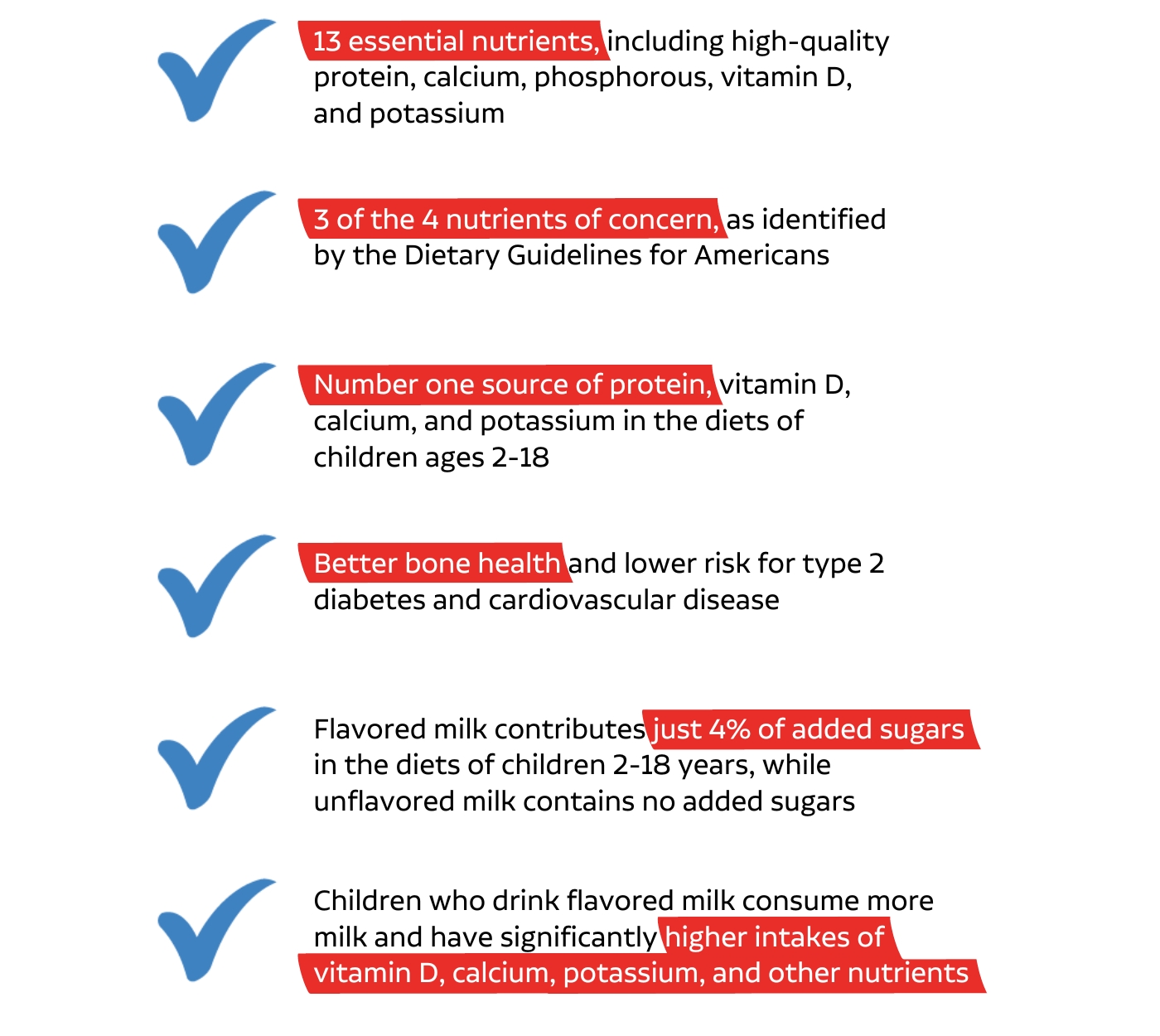
America’s dairy companies are committed to supporting families and students in their efforts to maintain a healthy diet and lifestyle. Nearly 30 million children and adolescents participate in federal school meal programs, including breakfast and lunch. The Healthy School Milk Commitment is a pledge by dairy companies to deliver milk’s 13 essential nutrients to America’s students while reducing calories and added sugars in flavored milk. Beginning with the 2025-2026 school year, 37 school milk processors representing more than 90% of the school milk volume in the United States commit to provide healthy, nutritious school milk options with no more than 10 grams of added sugar per 8 fluid ounce serving.


America’s dairy companies are committed to supporting families and students in their efforts to maintain a healthy diet and lifestyle. Nearly 30 million children and adolescents participate in federal school meal programs, including breakfast and lunch. Dairy and milk play a central role in school meals by providing 13 essential nutrients students need for healthy growth and development. Milk is the top source of calcium, potassium, phosphorus, and vitamin D in kids ages 2-18, and flavored milk is just as nutritious as white milk. As parents, policymakers, and nutrition professionals support making more milk options available with less added sugar per serving, the International Dairy Foods Association (IDFA), on behalf of America’s school milk processors, is leading a voluntary effort to reduce added sugars in school milk by the 2025-2026 school year.

Beginning with the 2025-2026 school year, school milk processors commit to providing school milk options with no more than 10 grams of added sugar per 8 fluid ounce serving. When the Commitment was announced in April 2023, flavored milk products offered in schools contained an average of 8.2 grams of added sugar per serving. By October 2024, the average had fallen to 7.4 grams of added sugar per serving.
This effort, known as the Healthy School Milk Commitment, aims to deliver milk’s 13 essential nutrients to America’s students while reducing calories and added sugars in flavored milk. The Healthy School Milk Commitment combines our industry’s passion for product innovation with a long-standing promise to provide healthy, nutritious dairy options to schoolkids everywhere. This includes developing new and reformulated milks with less added sugar and working with school meals professionals and nutrition professionals to educate school staff and students about the benefits of healthy milk options in the diets of children and adolescents.
Among milk options available in schools, low-fat flavored milk is the most-consumed beverage option for students regardless of grade. The Healthy School Milk Commitment ensures students will continue to have access to healthy dairy options consistent with the federal Dietary Guidelines for Americans.
The most recent Dietary Guidelines for Americans report is clear: children are not receiving enough essential nutrients for growth, development, healthy immune function, and overall wellness. Healthy milk and dairy options in school meals—including lactose-free and reduced-lactose options—are the most important opportunity of the day for children to get the critical nutrients they need. For years, parents and nutrition professionals have agreed that milk and dairy products must remain key building blocks in school meals. The Healthy School Milk Commitment affirms that promise and assures parents and students that healthy milk options will remain on school meal menus for decades to come.



Altogether, these fluid milk processors represent more than 90% of the flavored milk product volume provided to schools on an annual basis. Many companies on the list have several regional brands under their corporate flagship, such as Dairy Farmers of America, Prairie Farms Dairy, Shehadey Family Farms, HP Hood, and others.

Serving low-fat and fat-free flavored milk with school meals is in line with Dietary Guidelines for Americans recommendations because it contains the same exact 13 essential nutrients as unflavored milk in a flavor that children prefer to drink. Specifically, the DGA recommended both low-fat and fat-free milk as nutrient-dense foods and note that small amounts of added sugars can be added to nutrient-dense foods – including low-fat or fat-free milk – to help meet food group recommendations. Children who consume flavored milk drink more milk overall and have higher intakes of vitamins D, A, calcium, potassium and other nutrients than children who don't drink flavored milk. When flavored milk has been removed or restricted in school meals, children drink less milk and miss out on the nutrients provided by milk.
The Healthy School Milk Commitment covers all cow’s fluid milk options served in schools participating in the National School Lunch Program and the School Breakfast Program. The Commitment does not extend to other dairy products in school meals like cheese and yogurt, nor does it extend to plant-based beverages that are served as alternatives to cow’s milk.
Yes, the commitment applies to milk served to school children in grades K through 12 through the National School Lunch Program and the School Breakfast Program.
Yes, the Commitment covers milk provided to children in school in all 50 states, the District of Columbia, and Puerto Rico.
The Healthy School Milk Commitment offers a ceiling of 10 grams of added sugar per serving of milk in order to meet the 2020-2025 Dietary Guidelines for Americans report recommendation that children consume less than 10% of calories from added sugars. Specifically, the DGA recommended both low-fat and fat-free milk as nutrient-dense foods and note that small amounts of added sugars can be added to nutrient-dense foods – including low-fat or fat-free milk – to help meet food group recommendations. While the DGA recommendation of 10% of calories from added sugars applies to the full diet, not on a per-product basis, limiting school milk servings to 10 grams or less of added sugar will ensure that even the youngest school-aged children (grade group K-5) enjoy milk as part of a healthy breakfast and lunch.
The Commitment level of 10 grams of added sugar is about 7 grams less than the average level of added sugar in flavored school milk in the 2006-07 school year. The level of added sugar in school chocolate milk has decreased by 50% over the past 15 years. The average added sugar content decreased from 16.7 grams in school year 2006-07 to 8.2 grams in school year 2021-22.